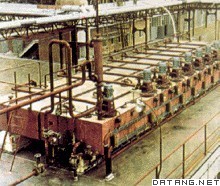1) extraction ability


萃取率,提取率
2) Yield of extract


提(萃)取物得率
3) extracting rate


萃取率
1.
In the present,the anion AOT/iso-octane system extract cottonseed protein the extracting rate to be higher than the positive ion CTAB/Octane(n-octanol or amyl alcohol) system.
讨论了阳离子CTAB/正辛烷(正辛醇或正戊醇)、阴离子AOT/异辛烷两种反胶束体系在不同条件下的W0与萃取率之间的关系。
2.
In the present,the Anion AOT/ iso-octane system extract sunflower seed protein the extracting rate to be high.
利用AOT[二-(2-乙基已基)琥珀酸酯磺酸钠]/异辛烷反胶束体系萃取葵花粕蛋白,讨论了温度、助表面活性剂的用量对体系增溶水的量(W0)的影响;(W0)对原料蛋白萃取率的影响。
4) Extraction rate


萃取率
1.
Effect of Ultrasonic treatment on raising the extraction rate of proteins and total solids from soybean slurry;
超声处理大豆浆体对提高蛋白质和固形物萃取率的作用
2.
5 the protein extraction rate is high(73.


采用碱提酸沉方法从双液相棉粕中制取棉籽蛋白,pH值对蛋白质和植酸的萃取率及沉淀率影响很大。
3.
Based on the current status of the insoluble sulfur production in China,this article discusses the ways to increase the high temperature stability,conversion rate,extraction rate,and the selection and market status of flammable,explosive extraction solvents,etc.
针对我国不溶性硫磺的生产现状,就其制造方法的选择,怎样提高高温稳定性、转化率、萃取率,以及易燃易爆、萃取溶剂的选择和市场情况等问题进行了探讨。
5) extraction yield


萃取率
1.
The effect of different factors on coal extraction yield-temperature, solvent, irradiation time were investigated under microwave-assisted extraction(MAE).
在微波辅助下,考察了萃取温度、溶剂种类、辐射时间对萃取率的影响。
2.
The extracted oil was analyzed for the extraction yield, the fatty acid composition and the quality.
采用超临界CO2萃取技术对番茄籽油进行萃取,经过单因素和优化实验,对不同萃取时间、压力和温度下油的萃取率、脂肪酸组成和品质进行了比较。
6) extraction rate


萃取速率
1.
The effects of interfacial area,the initial concentrations of H3PO4 and HCl in aqueous phase on the extraction rate of H3PO4 were studied.
采用上升液滴法研究了氯化物—磷酸体系中异戊醇萃取磷酸的动力学,考察了两相接触面积和水相中磷酸、盐酸初始浓度对磷酸萃取速率的影响。
2.
The results showed that the initial forward extraction rate of phosphoric acid was found to increase by increasing interfacial area between the two phases and the initial concentrations of hydrochloric acid and phosphoric acid in aqueous phase,and phosphoric acid extraction .
采用上升液滴法研究了异戊醇从氯化物-磷酸体系中萃取磷酸的动力学,结果表明磷酸的初始正向萃取速率随两相界面积、水相初始磷酸、盐酸浓度的增大而增大,异戊醇对磷酸的萃取可能属扩散控制模式。
补充资料:萃取
| 萃取 extraction 用液态的萃取剂处理与之不互溶的双组分或多组分溶液,实现组分分离的传质分离过程。又称溶剂萃取或液液萃取,也称抽提。是一种应用广泛的单元操作。其优点在于常温操作,节省能源,不涉及固体、气体,操作方便。 原理 向待分离溶液(料液)中加入与之不相互溶解(至多是部分互溶)的萃取剂,形成共存的两个液相。利用原溶剂与萃取剂对各组分的溶解度(包括经化学反应后的溶解)的差别,使它们不等地分配在两液相中,然后通过两液相的分离,实现组分间的分离。如碘的水溶液用四氯化碳萃取,几乎所有的碘都移到四氯化碳中,从而达到碘与大量的水的分离。 方法 ①单级萃取。料液与萃取剂在混合过程中密切接触,让被萃取的组分通过相际界面进入萃取剂,直到组分在两相间的分配基本达到平衡。然后静置沉降,分离成为两层液体。单级萃取萃取率较低。②多级错流萃取。料液和各级萃余液都与新鲜的萃取剂相接触。萃取率较高,但萃取剂用量大。③多级逆流萃取。料液与萃取剂分别从级联或板式塔的两端加入,在级间作逆向流动,最后成为萃余液和萃取液,各自从另一端离开。萃取率较高。是工业上常用的方法。④连续逆流萃取。在微分接触式萃取塔中,料液与萃取剂在逆向流动的过程中进行接触传质。是工业上常用的方法。
萃取剂 对萃取剂的基本要求是:①选择系数要大,可使产品的纯度提高。②对溶质的溶解度要大,即萃取剂用量就少。③与原溶剂的互溶度要小,即分离效果好。④粘度要少,界面张力适度,对料液有较大的密度差,以方便操作。⑤化学性质稳定,无毒性,挥发度低,不易燃烧。⑥价廉易得,或易于回收。 |
说明:补充资料仅用于学习参考,请勿用于其它任何用途。
参考词条
